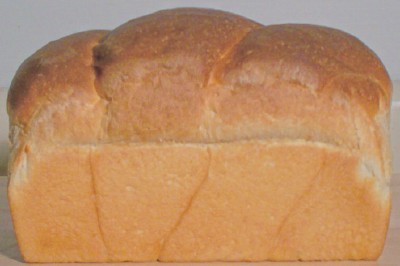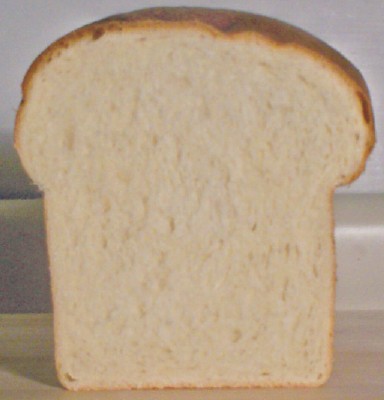
Buttermilk Twist White Bread (Re-mix Method)

This loaf was made using a modified re-mixed straight dough process, which was adapted from the "ful-flavor process", which dates back to 1959. The formula for this bread is fairly standard:
- 100% Bread Flour (contained no ascorbic acid)
- 3.3% Buttermilk Powder
- 3.3 % Shortening
- 0.19 % Lecithin Granules
- 0.8 % Instant Dry Yeast
- 67% Water (variable)
- 3.3 % Sugar
- 2% Salt
The flour weight for this batch was 15 oz (425 grams). The loaf was baked in a standard 8.5" x 4.5" loaf pan. The final weight was 26.75 oz (758 g).

The procedure for remixing a straight dough is a follows:
1) All of the ingredients, except salt and sugar, are mixed together at slow speed.
2) The dough is fermented in the covered mixing bowl for about 2½ hours.
3) Following fermentation, the salt and sugar are added and the dough is remixed to optimum condition.
4) After a short rest, the dough is moulded and panned in a normal fashion. Proofing and baking are carried out as with a straight dough.
Probably the biggest advantage to remixing dough is the elimination of punching, folding, or stretching the dough to develop the gluten. When properly re-mixed, the dough emerges from the mixer bowl in a fully developed state (not unlike dough produced in a bread machine).


Comments
I'm still searching for the "perfect" white sandwich bread. I will try this method. Thanks.
After the first mixing, the dough will feel fairly dry, but soft (probably because of the lack of salt). Do not panic and add more water at this point. Be careful not to over-mix (or under-mix) during re-mix. Under-mixed dough is stiff, while over-mixed dough becomes sticky and hard to handle. The re-mix time for the loaf pictured was 5 minutes at speed 2 (KA K5SS equipped with spiral hook).
What is the Lecinith granuals for?
How was the taste? I usually let my straight doughs bulk retard in the refrigerator overnight to develop more flavor. You may want to try that and see if it makes this beautiful loaf even better.
Soy lecithin was the first emulsifier used in bread production (technically, it is a surfactant). During make-up, it gives the dough a much drier feel, and less dusting flour is required. It is also purported to promote loaf symmetry and aid in mixing. Bread made with lecithin has a softer crumb and better keeping qualities.
This bread has a pleasant, mild flavor which is complemented by the dried buttermilk. For a more complex flavor, I sometimes substitute 4% honey for the sugar. I gave a loaf to my next door neighbors recently, and they pronounced it "excellent" (even though the crumb was somewhat dense and the volume was reduced). The next day I increased the absorption by 3% and produced the loaf that is pictured in this blog.